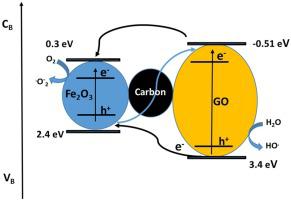Journal of Water Process Engineering ( IF 6.3 ) Pub Date : 2020-12-29 , DOI: 10.1016/j.jwpe.2020.101865 Ajibola A. Bayode , Dayana M. dos Santos , Martins O. Omorogie , Olumide D. Olukanni , Roshila Moodley , Olusola Bodede , Foluso O. Agunbiade , Andreas Taubert , Andrea S.S. de Camargo , Hellmut Eckert , Eny Maria Vieira , Emmanuel I. Unuabonah

|
This study reports the development of efficient photosensitive nanocomposites made from clay, Fe2O3, and graphene oxide (GO). These nanocomposites were used for the removal of steroid estrogens (E1, E2, E3 and EE2) from water under visible-light. The use of these photocatalytic nanocomposites led to oxidation of the steroid estrogens at >80 % even under simultaneous presence of all estrogens in water. Mineralization was obtained for these estrogens within the range of 58–73 %. The presence of Fe-oxide in the nanocomposites increased the photocatalytic efficiency but addition of GO further improved the photocatalytic efficiency. This improved efficiency was further doubled when the nanocomposites were prepared with a carbon source (Carica papaya seeds). The presence of carbon in the nanocomposite matrix was confirmed using X-ray photoelectron spectroscopy and Elemental analysis. The main contributors to photocatalytic efficiency of these nanocomposites are superoxide radicals (· ) and holes (h+). Under competitive conditions, the photocatalysts are still active although the extent of estrogen oxidation is somewhat lower. Changes in the ionic strength did not significantly influence the efficiency of the photocatalyst. This signifies that adsorption only plays a minor role in estrogen removal from water. Toxicity tests show that the treated water is safe for human consumption and the most efficient nanocomposite can be recycled three times without any significant loss of performance. Overall, the nanocomposite show high potential for the effective removal of a cocktail of estrogens in raw wastewater, tap and rain water, attaining contamination levels that are within WHO safe limits.
中文翻译:

碳介导的可见光粘土-Fe 2 O 3-氧化石墨烯催化纳米复合材料,用于去除水中的甾体雌激素
这项研究报告了由粘土,Fe 2 O 3和氧化石墨烯(GO)制成的高效光敏纳米复合材料的开发。这些纳米复合材料用于在可见光下从水中去除类固醇雌激素(E1,E2,E3和EE2)。即使在水中同时存在所有雌激素的情况下,这些光催化纳米复合材料的使用也导致甾体雌激素的氧化率> 80%。这些雌激素的矿化程度为58-73%。纳米复合物中Fe-氧化物的存在增加了光催化效率,但是GO的加入进一步提高了光催化效率。当用碳源(番木瓜)制备纳米复合材料时,这种提高的效率进一步加倍。种子)。使用X射线光电子能谱和元素分析证实了纳米复合材料基质中碳的存在。这些纳米复合材料的光催化效率的主要贡献者是超氧自由基(·)和孔(h +)。在竞争条件下,尽管雌激素的氧化程度略低,但光催化剂仍然具有活性。离子强度的变化没有显着影响光催化剂的效率。这表明吸附仅在从水中去除雌激素中起次要作用。毒性测试表明,经过处理的水可以安全地供人类食用,并且最有效的纳米复合材料可以循环使用三遍,而性能不会受到任何重大损失。总体而言,纳米复合材料显示出有效去除原废水,自来水和雨水中的雌激素混合物的巨大潜力,其污染水平在WHO安全限值之内。











































 京公网安备 11010802027423号
京公网安备 11010802027423号